- Calendar
- Online Ticket Sales
- Access
- JA
- EN
In the Country of Fans, Japan
November 28, 2018 to January 20, 2019
*There will be an exhibition change during the course of exhibition
*This exhibition will travel to Yamaguchi Prefectural Art Museum (March 20 to May 6, 2019).
*Download the list of changes in works on display
The list of changes in worksPDF
Introduction
This is the Country of Fans
In 1878, when Japan’s modern period had barely begun, the Meiji government participated, as “Japon,” in the Paris International Exposition. That exhibit fanned the passion for Japonisme, which was already sweeping over Europe and America. The items that Japan exhibited included, it is reported, a hundred folding fans, works covering a wide range of periods and schools.
The hundred fans that probably adorned the Japan Pavilion were selected to communicate, to a broad audience overseas, the distinctive nature of Japanese painting—from the Kano and Tosa schools to ink painting, ukiyo-e, and literati painting. The folding fan was thus both a major export product and an image chosen by the Meiji government as a cultural symbol of Japan.
In the introductory section, through folding fans thought to have been exhibited at the Paris International Exposition, we introduce “Japan, the Country of Fans,” the land that enthralled the world.
Section 1
The Mystical Power of Folding Fans
Folding fans can be divided into two types. The hiogi, a folding fan made of overlapping thin strips of hinoki cypress tied together, originated, it is thought, in the Nara period (710-794). The kamiogi, in which a silk or paper fan leaf is glued to a bamboo frame, was created somewhat later, at the beginning of the Heian period (794-1185).
These fans were more than useful accessories for cooling oneself. They were also essential for use in ritual and ceremony. By the mid-Heian period, the garments to be worn by aristocrats had been codified, with folding fans a part of their costumes: cypress fans in winter and paper fans in summer. Demand for the appropriate fan to suit the season and the wearer’s gender and age spurred the development of the decorative nature of Japan’s folding fans.
That the cypress fan became a customary accessory worn with formal attire, regardless of the season, demonstrates that fans could do more than generate a breeze. In this section, we explore fans as fetishes or talismans, embodiments of the mystical power to connect human beings with Shinto and Buddhist deities. That spiritual power can be seen in their use as objects of worship in Shinto rituals and festivals, as donations buried in Buddhist sutra mounds, and as offerings interred inside Buddhist statues.
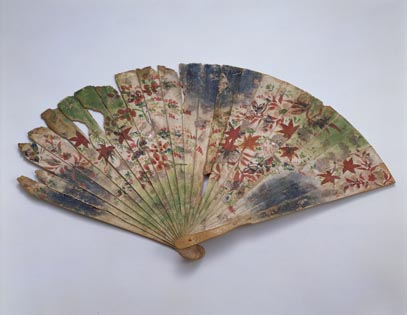
Heian period, 12th century
Sada Jinjya Shrine, Shimane (on deposit to Shimane Museum of Ancient Izumo)
【To be shown between Nov. 28 and Dec. 24】
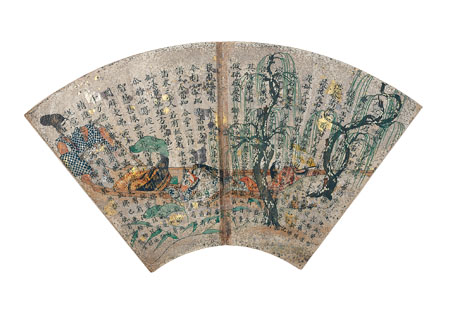
Heian period, 12th century
Shitenno-ji Temple, Osaka
【To be shown between Dec. 12 and Dec. 24】
Section 2
Fans Floating Away
Paintings and texts from the medieval to the beginning of the early modern period (ca. 13th-17th century) often depict ogi nagashi, tossing a folding fan from a high point onto the water’s surface and enjoying its changing appearance as it falls and then drifts away. Ogi nagashi paintings were also created by combining images of scattered folding fans decorating folding screens or sliding doors with a background of flowing water and waves. A profusion of such paintings was created from the middle ages on.
The fan combined with flowing water, its form changing as it floats along, eventually to disappear evokes both the charm of that visual experience and the evanescence of life. An episode from a Kamakura period (1185-1333) collection of Buddhist tales, the Miracles at Hase-dera Temple, states, “Where the fan drifts shows us where the person one loves is, so that we can meet again.” The fan is seen as a tool that can determine one’s fate, connecting man and woman, reconnecting one human being with another.
This section presents the development of the floating fan motif, with its evanescent beauty, and the rich variety of works resulting from combining that motif with other themes.
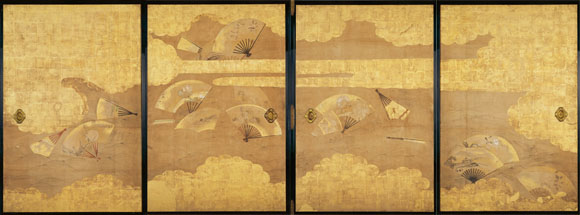
four panels from the north side of the first room in the Shogunate bathing rooms at Nagoya Castle)
Edo period, ca. 1633
Nagoya Castle Office
【To be shown over an entire period】

six panels, Edo period, 17th century
Suntory Museum of Art
【To be shown over an entire period】
Section 3
Distributing Fans
Starting in the late tenth century, folding fans were sent as tribute items from Japan to the Asian mainland. In China, these fans experienced a surge in popularity during the Ming period (1368-1644). Folding fans ranked with folding screens and swords as major, and greatly appreciated, export items in Japan’s trade with Ming China.
In Japan, folding fans were used in seasonal gift exchanges throughout the medieval period. They had also become indispensable accessories carried everywhere in daily life.
The enormous demand for these fans, in Japan and abroad, naturally spurred increased production. The trade in folding fans is regarded as producing a noteworthy development: the first instance of a linkage between art and commerce. In the past, almost all objects of art—fans, folding screens, or picture scrolls, for example—had been custom made. Fans, however, led the way with the emergence of ready-made, commercially available works of art. By the midfourteenth century, ready-made fans were being sold in shops. Many people, regardless of status, could thus enjoy these examples of commercial art.
This section introduces a host of folding fans that circulated among people and also served as a means of communication, facilitating their interactions.
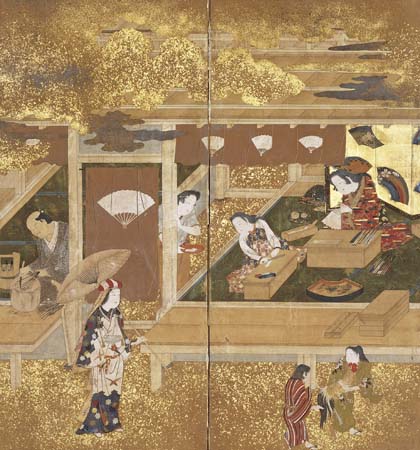
two-fold screen, Edo period, 17th century
Osaka City Museum of Fine Arts (Taman Collection)
【To be shown over an entire period】
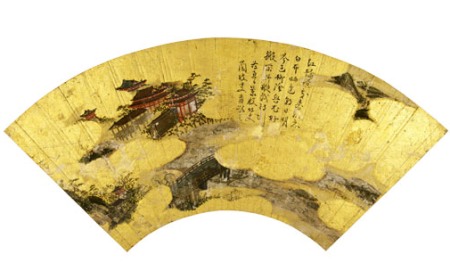
one album, Muromachi–Momoyama period, 15th–16th century
Nara National Museum (Photo by Kinji Morimura)
【To be shown over an entire period】
Section 4
Folding Fans and the Literary Arts
The paintings on folding fans are works of art that their owners can enjoy privately, whenever and wherever they choose. Since fans are so portable, people can also easily display the paintings to others. Actively circulated and exchanged between people, fans played a vital role in disseminating painting subjects and compositions.
With the folding fan—a canvas on which carefully selected images could readily be applied and shared—it was particularly easy to depict a specific scene from a long tale. Such images were readily appreciated and became quite popular subjects. Folding fans presented famous scenes in digest form, but also did more: by attaching fan paintings to folding screens or collecting them in albums of paintings, people could savor the entire story.
The distinct quality of fan paintings, with motifs chosen with care to suit the small picture plane, has much in common with waka poetry, which expresses its subject in a limited number of syllables. That connection led, in the late Muromachi period (1336-1573), to the development of what are called ogi no soshi, “fan-shaped paintings with waka poems,” a genre with puzzle-solving elements in which waka poems were guessed at based on the paintings on folding fans.
This section offers an opportunity to enjoy the rich literary world that unfolded on fans, condensed onto a distinctive picture plane formed of straight and curved lines.
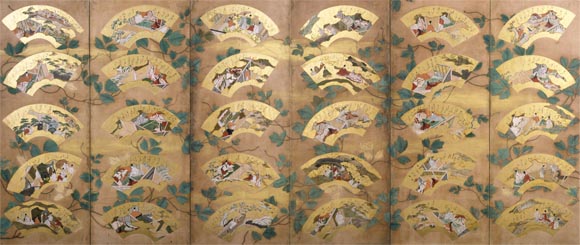
Muromachi period, first half of 16th century
Jodo-ji Temple, Hiroshima (Photo by Koji Murakami)
【To be shown over an entire period】
Section 5
Folding Fans Flourish
Folding fan paintings could be said to be the paintings most produced in Japan and also, since the fans are consumables, the most lost. Almost no artists in the Edo period (1603-1868) did not produce fan paintings. Members of the Kano school, who were artists by appointment to the shogun and daimyos, members of the Tosa school, who were court painters, and artists from the host of new schools that emerged with support from the commoner class all applied their individual styles and skills in creating fan paintings. Moreover, they daringly developed new compositions, subject matter, and techniques in these works.
Folding fans were being sold, ready made, in stores from early in the medieval period. By the mid-Edo period, peddlers known as “folding fan sellers” or “fan paper sellers” were strolling the city, bringing fans to the street and to one’s doorstep. Folding fans had become highly accessible, cutting-edge fashion items, and the paintings on them became the object of intense interest.
This section presents fan paintings, in all their rich variety, from the Edo period. Created by artists from every school of painting, they offer a remarkably broad and intense experience.
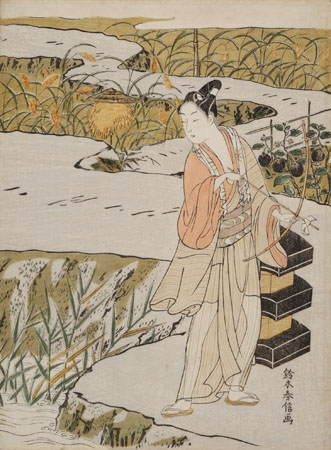
Suzuki Harunobu, one sheet, Edo period, ca. 1766–1767
Private Collection
【To be shown between Dec. 26 and Jan. 20】
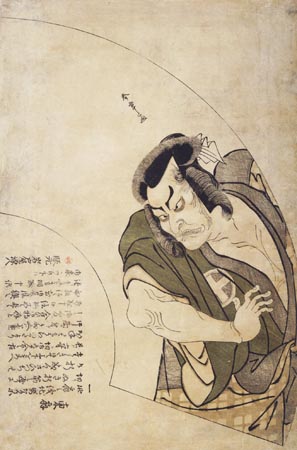
Katsukawa Shunsho, one sheet, Edo period, ca. 1772–1789
Chiba City Museum of Art
【To be shown between Dec. 19 and Jan. 20】
Conclusion
The Folding Fan Unfurls
Folding fans are enjoyed as auspicious objects symbolizing prosperity, since they expand when opened, suggesting a prosperous future unfolding.
That form, spreading out when a fan is opened, was more than the frame for creating a painting. It transcended painting to emerge in the worlds of weaving and dyeing and other crafts. The fan’s richly varied forms—open, closed, partially open—inspired the creation of bold designs that added beauty to people’s lives.
While the fan’s functions, its utility, were never forgotten, design themes associated with it developed freely, in large and small forms and in two and three dimensions, in both painting and the craft arts.
In this concluding section, we introduce the diverse transformations and further evolution occurring in world of the folding fan, particularly in the early modern period.
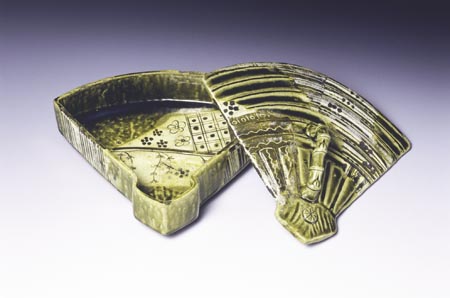
Momoyama period, 17th century
Umezawa Memorial Museum
【To be shown over an entire period】
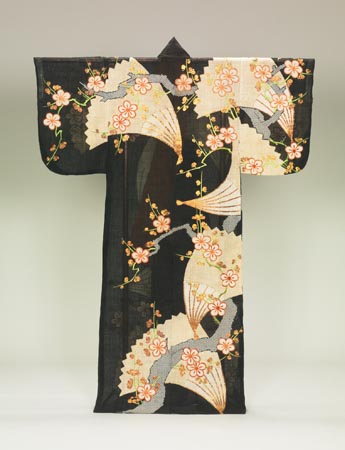
Edo period, 18th century
Joshibi University of Art and Design Art Museum
【To be shown between Nov. 28 and Dec. 10】
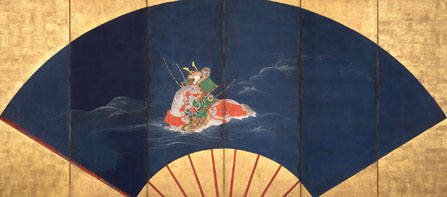
Kaiho Yusetsu, pair of six-fold screens (lefthand screen)
Edo period, 17th century
Saitama Prefectural Museum of History and Folklore
【To be shown between Nov. 28 and Dec. 24】
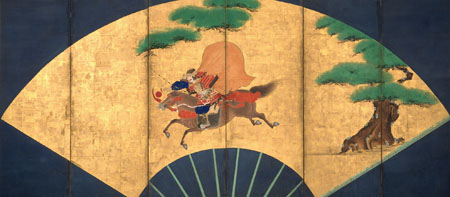
Kaiho Yusetsu, pair of six-fold screens (righthand screen)
Edo period, 17th century
Saitama Prefectural Museum of History and Folklore
【To be shown between Nov. 28 and Dec. 24】
*Unauthorized reproduction or use of texts or images from this site is prohibited.
2025 January
- Exhibition
- Closed
- Tea Ceremony
- Mon
- Tue
- Wed
- Thu
- Fri
- Sat
- Sun
- 1
- 2
- 3
- 4
- 5
- 6
- 7
- 8
- 9
- 10
- 11
- 12
- 13
- 14
- 15
- 16
- 17
- 18
- 19
- 20
- 21
- 22
- 23
- 24
- 25
- 26
- 27
- 28
- 29
- 30
- 31
2025 February
- Exhibition
- Closed
- Tea Ceremony
- Mon
- Tue
- Wed
- Thu
- Fri
- Sat
- Sun
- 1
- 2
- 3
- 4
- 5
- 6
- 7
- 8
- 9
- 10
- 11
- 12
- 13
- 14
- 15
- 16
- 17
- 18
- 19
- 20
- 21
- 22
- 23
- 24
- 25
- 26
- 27
- 28
2025 March
- Exhibition
- Closed
- Tea Ceremony
- Mon
- Tue
- Wed
- Thu
- Fri
- Sat
- Sun
- 1
- 2
- 3
- 4
- 5
- 6
- 7
- 8
- 9
- 10
- 11
- 12
- 13
- 14
- 15
- 16
- 17
- 18
- 19
- 20
- 21
- 22
- 23
- 24
- 25
- 26
- 27
- 28
- 29
- 30
- 31
2025 April
- Exhibition
- Closed
- Tea Ceremony
- Mon
- Tue
- Wed
- Thu
- Fri
- Sat
- Sun
- 1
- 2
- 3
- 4
- 5
- 6
- 7
- 8
- 9
- 10
- 11
- 12
- 13
- 14
- 15
- 16
- 17
- 18
- 19
- 20
- 21
- 22
- 23
- 24
- 25
- 26
- 27
- 28
- 29
- 30
2025 May
- Exhibition
- Closed
- Tea Ceremony
- Mon
- Tue
- Wed
- Thu
- Fri
- Sat
- Sun
- 1
- 2
- 3
- 4
- 5
- 6
- 7
- 8
- 9
- 10
- 11
- 12
- 13
- 14
- 15
- 16
- 17
- 18
- 19
- 20
- 21
- 22
- 23
- 24
- 25
- 26
- 27
- 28
- 29
- 30
- 31
2025 June
- Exhibition
- Closed
- Tea Ceremony
- Mon
- Tue
- Wed
- Thu
- Fri
- Sat
- Sun
- 1
- 2
- 3
- 4
- 5
- 6
- 7
- 8
- 9
- 10
- 11
- 12
- 13
- 14
- 15
- 16
- 17
- 18
- 19
- 20
- 21
- 22
- 23
- 24
- 25
- 26
- 27
- 28
- 29
- 30
2025 July
- Exhibition
- Closed
- Tea Ceremony
- Mon
- Tue
- Wed
- Thu
- Fri
- Sat
- Sun
- 1
- 2
- 3
- 4
- 5
- 6
- 7
- 8
- 9
- 10
- 11
- 12
- 13
- 14
- 15
- 16
- 17
- 18
- 19
- 20
- 21
- 22
- 23
- 24
- 25
- 26
- 27
- 28
- 29
- 30
- 31
2025 August
- Exhibition
- Closed
- Tea Ceremony
- Mon
- Tue
- Wed
- Thu
- Fri
- Sat
- Sun
- 1
- 2
- 3
- 4
- 5
- 6
- 7
- 8
- 9
- 10
- 11
- 12
- 13
- 14
- 15
- 16
- 17
- 18
- 19
- 20
- 21
- 22
- 23
- 24
- 25
- 26
- 27
- 28
- 29
- 30
- 31
2025 September
- Exhibition
- Closed
- Tea Ceremony
- Mon
- Tue
- Wed
- Thu
- Fri
- Sat
- Sun
- 1
- 2
- 3
- 4
- 5
- 6
- 7
- 8
- 9
- 10
- 11
- 12
- 13
- 14
- 15
- 16
- 17
- 18
- 19
- 20
- 21
- 22
- 23
- 24
- 25
- 26
- 27
- 28
- 29
- 30
2025 October
- Exhibition
- Closed
- Tea Ceremony
- Mon
- Tue
- Wed
- Thu
- Fri
- Sat
- Sun
- 1
- 2
- 3
- 4
- 5
- 6
- 7
- 8
- 9
- 10
- 11
- 12
- 13
- 14
- 15
- 16
- 17
- 18
- 19
- 20
- 21
- 22
- 23
- 24
- 25
- 26
- 27
- 28
- 29
- 30
- 31
2025 November
- Exhibition
- Closed
- Tea Ceremony
- Mon
- Tue
- Wed
- Thu
- Fri
- Sat
- Sun
- 1
- 2
- 3
- 4
- 5
- 6
- 7
- 8
- 9
- 10
- 11
- 12
- 13
- 14
- 15
- 16
- 17
- 18
- 19
- 20
- 21
- 22
- 23
- 24
- 25
- 26
- 27
- 28
- 29
- 30
2025 December
- Exhibition
- Closed
- Tea Ceremony
- Mon
- Tue
- Wed
- Thu
- Fri
- Sat
- Sun
- 1
- 2
- 3
- 4
- 5
- 6
- 7
- 8
- 9
- 10
- 11
- 12
- 13
- 14
- 15
- 16
- 17
- 18
- 19
- 20
- 21
- 22
- 23
- 24
- 25
- 26
- 27
- 28
- 29
- 30
- 31
2026 January
- Exhibition
- Closed
- Tea Ceremony
- Mon
- Tue
- Wed
- Thu
- Fri
- Sat
- Sun
- 1
- 2
- 3
- 4
- 5
- 6
- 7
- 8
- 9
- 10
- 11
- 12
- 13
- 14
- 15
- 16
- 17
- 18
- 19
- 20
- 21
- 22
- 23
- 24
- 25
- 26
- 27
- 28
- 29
- 30
- 31
2026 February
- Exhibition
- Closed
- Mon
- Tue
- Wed
- Thu
- Fri
- Sat
- Sun
- 1
- 2
- 3
- 4
- 5
- 6
- 7
- 8
- 9
- 10
- 11
- 12
- 13
- 14
- 15
- 16
- 17
- 18
- 19
- 20
- 21
- 22
- 23
- 24
- 25
- 26
- 27
- 28
2026 March
- Exhibition
- Closed
- Mon
- Tue
- Wed
- Thu
- Fri
- Sat
- Sun
- 1
- 2
- 3
- 4
- 5
- 6
- 7
- 8
- 9
- 10
- 11
- 12
- 13
- 14
- 15
- 16
- 17
- 18
- 19
- 20
- 21
- 22
- 23
- 24
- 25
- 26
- 27
- 28
- 29
- 30
- 31
2026 April
- Exhibition
- Closed
- Mon
- Tue
- Wed
- Thu
- Fri
- Sat
- Sun
- 1
- 2
- 3
- 4
- 5
- 6
- 7
- 8
- 9
- 10
- 11
- 12
- 13
- 14
- 15
- 16
- 17
- 18
- 19
- 20
- 21
- 22
- 23
- 24
- 25
- 26
- 27
- 28
- 29
- 30
2026 May
- Exhibition
- Closed
- Mon
- Tue
- Wed
- Thu
- Fri
- Sat
- Sun
- 1
- 2
- 3
- 4
- 5
- 6
- 7
- 8
- 9
- 10
- 11
- 12
- 13
- 14
- 15
- 16
- 17
- 18
- 19
- 20
- 21
- 22
- 23
- 24
- 25
- 26
- 27
- 28
- 29
- 30
- 31
2026 June
- Exhibition
- Closed
- Mon
- Tue
- Wed
- Thu
- Fri
- Sat
- Sun
- 1
- 2
- 3
- 4
- 5
- 6
- 7
- 8
- 9
- 10
- 11
- 12
- 13
- 14
- 15
- 16
- 17
- 18
- 19
- 20
- 21
- 22
- 23
- 24
- 25
- 26
- 27
- 28
- 29
- 30
2026 July
- Exhibition
- Closed
- Mon
- Tue
- Wed
- Thu
- Fri
- Sat
- Sun
- 1
- 2
- 3
- 4
- 5
- 6
- 7
- 8
- 9
- 10
- 11
- 12
- 13
- 14
- 15
- 16
- 17
- 18
- 19
- 20
- 21
- 22
- 23
- 24
- 25
- 26
- 27
- 28
- 29
- 30
- 31
2026 August
- Exhibition
- Closed
- Mon
- Tue
- Wed
- Thu
- Fri
- Sat
- Sun
- 1
- 2
- 3
- 4
- 5
- 6
- 7
- 8
- 9
- 10
- 11
- 12
- 13
- 14
- 15
- 16
- 17
- 18
- 19
- 20
- 21
- 22
- 23
- 24
- 25
- 26
- 27
- 28
- 29
- 30
- 31
2026 September
- Exhibition
- Closed
- Mon
- Tue
- Wed
- Thu
- Fri
- Sat
- Sun
- 1
- 2
- 3
- 4
- 5
- 6
- 7
- 8
- 9
- 10
- 11
- 12
- 13
- 14
- 15
- 16
- 17
- 18
- 19
- 20
- 21
- 22
- 23
- 24
- 25
- 26
- 27
- 28
- 29
- 30
2026 October
- Exhibition
- Closed
- Mon
- Tue
- Wed
- Thu
- Fri
- Sat
- Sun
- 1
- 2
- 3
- 4
- 5
- 6
- 7
- 8
- 9
- 10
- 11
- 12
- 13
- 14
- 15
- 16
- 17
- 18
- 19
- 20
- 21
- 22
- 23
- 24
- 25
- 26
- 27
- 28
- 29
- 30
- 31
2026 November
- Exhibition
- Closed
- Mon
- Tue
- Wed
- Thu
- Fri
- Sat
- Sun
- 1
- 2
- 3
- 4
- 5
- 6
- 7
- 8
- 9
- 10
- 11
- 12
- 13
- 14
- 15
- 16
- 17
- 18
- 19
- 20
- 21
- 22
- 23
- 24
- 25
- 26
- 27
- 28
- 29
- 30
2026 December
- Exhibition
- Closed
- Mon
- Tue
- Wed
- Thu
- Fri
- Sat
- Sun
- 1
- 2
- 3
- 4
- 5
- 6
- 7
- 8
- 9
- 10
- 11
- 12
- 13
- 14
- 15
- 16
- 17
- 18
- 19
- 20
- 21
- 22
- 23
- 24
- 25
- 26
- 27
- 28
- 29
- 30
- 31
